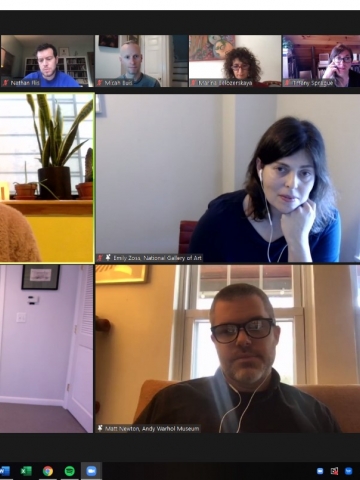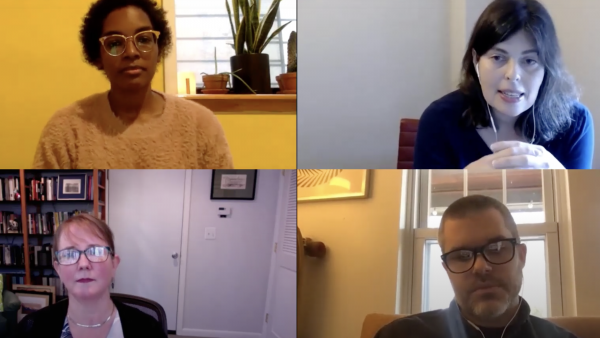Article |
What does burnout mean to museum publishers?
A group conversation explores this timely question

(Chicago, IL) Publishing professionals from museums across the country convened during a moderated discussion to consider the various types of burnout our teams are experiencing, share perspectives, and offer solutions that have alleviated stress in our experiences. The event began with a poll; on a five point scale, only 7% of the attendees rated their level of burnout at two or less (none, to slight burnout). All other attendees rated their experience as moderate, intense, or overwhelming.
What does Burnout Mean to You?
On December 11, 2020, Kamilah Foreman (Dia Art Foundation) led three speakers on this topic: Emily Zoss (National Gallery of Art), Suzanne Abrams Rebillard (Corning Museum of Glass), and Matt Newton (Andy Warhol Museum).
Attendees of the event were asked to generate a one-sentence definition of what burnout means to them. Their answers are listed anonymously below.
Burnout is exhaustion from never feeling like the work is done or ever will be done.
Burnout is never being able to step off the treadmill!
Burnout is continuing to act like it's business as usual when nothing is usual
Burnout is having to work on something else while attending a session about avoiding burnout.
Burnout is a when a car runs out of gas in the middle of a highway, and you’re the car.
Burnout is work-related nightmares!
Burnout is exhaustion.
Burnout is that feeling of “not this, again.”
Burnout is working above and beyond with no end in sight and no back up.
Burnout is working so many hours for so long that you forget what to do when you’re not working.
Burnout is working to the point where you lose energy for the rest of your life.
Burnout is when it’s noon and you realize you’ve forgotten to brush your teeth! Again!
Burnout is where overwhelm meets apathy.
Burnout is living under a constant cloud - which pours stress over your head some days and drizzles glumly the rest of the time, with work anxiety compounded by political turmoils, epidemic fears, economic doom - the relentlessness of it all.
Burnout is somehow working a lot more but getting less done.
Burnout is the result of physical, mental, and/or emotional exhaustion; one of the most frightening outcomes (or symptoms?) is the inability to be creative, or the lack of incentive to care anymore about contributing creatively.
Burnout is making a list of high-priority tasks in the morning, and then repeating the same list the next day with a few new items added.
Burnout is the feeling of constant drain, inability to focus or think creatively or passionately. The constant state of unrest.
Burnout is reminding yourself and others of preexisting strategies that helped keep work on track and relatively balanced in the past but have somehow evaporated into the chaos of now.

The latter half of the event asked the audience and speakers to provide specific suggestions for avoiding / mitigating burnout. Their anonymous suggestions are listed below.
- Cap meetings to fifty minutes.
- Set office-wide days as “no-meeting” days.
- Encourage employees to take time to disconnect during the day – as part of their job.
- Add time each day to review material from other institutions for inspiration.
- Share update documents weekly instead of via live meetings; schedule twenty minute meetings for questions; select days of the week as “meeting-free” days for employees to focus on tasks.
- 40% is the new 100% standard of perfection as measured by industry productivity. This is because of the extra time it takes to build new processes.
- “Structural change from above is crucial—more vacation days, pay increases for junior staff, mental health resources, better health insurance, more accountability and transparency from senior staff, and commitments to equity, anti-racism, decolonization throughout the whole institution (more difficult but still important and relevant).”
- Celebrating successes. Meetings shouldn’t always be about difficulties and immediate challenges. Carve out time to celebrate staff accomplishments and completed projects.
- Some colleagues are meeting up to take socially-distanced walks in nature.
- Set boundaries by not responding to colleague emails sent outside of office hours. Take all your vacation days possible.
- Fight for the four-day work week.
- Real world connections: supplement the usual potluck by sending gift cards to staff for bakeries.
- Some leaders have sent other gift cards and thank you gifts to teams.
- Offer to fund a small technology budget to each employee to improve work from home set ups.
- Set social media “dark” times (with appropriate messaging) to give all staff time away from work.
- Some institutions are expanding holiday breaks (with additional paid time) to encourage team-wide breaks during the slow season.
- Be brutally honest with others about what you are capable of. Over-promising is the beginning of burnout.
- Take time to say good job to others. Send one genuine thank you email to someone each work day to recognize their work.
- Reserve email inboxes for non-urgent messages. Calls and direct messages can be used for emergencies.
- Set specific out of office messages to indicate why you will be responding slowly.
- “I’m receiving a high volume of emails. If you need urgent assistance, please contact [email address].”
- "I am single-tasking today and only responding to emails related to ____."
- "It is normal for me to take 2 days to read my emails and 2 more days to reflect on the matter and respond calmly. The culture of immediacy and the constant fragmentation. of time are not very compatible with the kind of life I lead." – from NYT
To emulate the suggestions we received, the event recording and formal meeting ended at 1:50 pm CST - 10 minutes early. Attendees with additional questions were invited to stay and talk to the speakers.
One takeaway from our meeting was the importance of kindness, and how easy it can be to forget to take the extra moments to compliment far-flung colleagues. Our advice? Make sure to carve out time for celebrations, and send one email a week genuinely thanking a colleague for their work.

